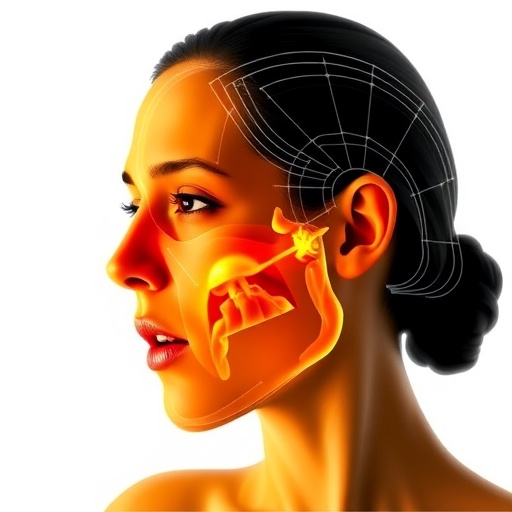In the intricate field of forensic anthropology, accurate sex estimation remains a cornerstone for identification processes in both contemporary and archaeological contexts. A newly published study by Tanga and Viciano, featured in the International Journal of Legal Medicine in 2025, pioneers the utilization of alveolar measurements—a nuanced yet underexplored craniofacial metric—to enhance predictive models for sex estimation. This breakthrough work explores a contemporary Italian sample, illuminating the subtle morphometric variations within the alveolar region of the human maxilla and mandible, and successfully harnesses these differences to refine sex classification methods.
Sex estimation traditionally relies on a combination of robust skeletal traits, predominantly from the pelvis and skull, known for their marked sexual dimorphism. However, these conventional landmarks may not always be accessible, particularly in fragmented or degraded forensic remains. The alveolar region, encompassing the bony ridge containing the dental sockets, presents a novel anatomical frontier ripe for investigation. This study capitalizes on that potential, analyzing precise alveolar parameters with advanced imaging and statistical modeling techniques to create predictive frameworks outperforming previous morphological assessments.
The research delves into quantitative metrics of the alveolar process, focusing on dimensions such as alveolar height, width, and curvature, captured through high-resolution digital imaging of maxillary and mandibular specimens. Tanga and Viciano meticulously collected alveolar measurements from a carefully curated cohort of contemporary Italians, ensuring a homogeneous population to control for ethnic and environmental variables. These comprehensive linear and angular data points form the basis of their robust multivariate analyses.
.adsslot_yIhCavKzkr{width:728px !important;height:90px !important;}
@media(max-width:1199px){ .adsslot_yIhCavKzkr{width:468px !important;height:60px !important;}
}
@media(max-width:767px){ .adsslot_yIhCavKzkr{width:320px !important;height:50px !important;}
}
ADVERTISEMENT
By applying discriminant function analyses and logistic regression models, the researchers sought to uncover patterns of sexual dimorphism embedded within alveolar topography. The resultant predictive models displayed remarkable sensitivity and specificity, with certain alveolar dimensions emerging as strong sex indicators. The study provides evidence that both maxillary and mandibular alveolar features possess statistically significant differences between males and females, suggesting these parameters can serve as reliable proxies in forensic identification.
The implications of integrating alveolar measurements into forensic practice extend beyond methodological innovation. This approach offers practical advantages by expanding the toolkit for examiners working with incomplete craniofacial remains, where classical sex differentiation features might be compromised. Moreover, the focus on a contemporary population ensures the models’ relevance and applicability within modern forensic contexts, a critical consideration given potential secular changes in skeletal morphology.
Technically, Tanga and Viciano leveraged state-of-the-art imaging modalities to capture alveolar landmarks with precision. Employing three-dimensional scanning and image processing software, they transcended the limitations of manual caliper measurements, reducing observer error and improving repeatability. This methodological rigor underpins the reliability of their findings, showcasing how technological advancements facilitate fresh insights into skeletal biology.
The study also addresses the biological underpinnings of alveolar sexual dimorphism, linking morphometric differences to developmental and functional factors. Higher masticatory forces in males likely contribute to increased alveolar robusticity, while hormonal influences during growth modulate bone remodeling dynamics. Understanding these physiological mechanisms enriches forensic interpretations, allowing experts to contextualize metric data within broader biological frameworks.
Importantly, Tanga and Viciano’s research underscores the need for population-specific standards in forensic anthropology. Their focus on an Italian demographic is essential to account for genetic and environmental heterogeneity influencing craniofacial traits. They emphasize that predictive models must be appropriately calibrated to the populations from which forensic samples derive, cautioning against uncritical extrapolation across diverse ethnic groups.
Beyond forensic applications, the study’s findings resonate with paleoanthropology and bioarchaeology, where sex estimation is foundational for reconstructing past human populations. The alveolar region, often preserved in cranial remains, can thus provide additional resolution in sex determination, enriching demographic and behavioral interpretations of archaeological sites.
This research also invites a reevaluation of traditional notions surrounding the craniofacial skeleton’s sexual dimorphism. By focusing on a less conventionally assessed region, Tanga and Viciano demonstrate the value of exploring alternative anatomical markers. Their success suggests that forensic anthropology can benefit from embracing a more holistic morphological perspective, incorporating multiple skeletal regions and leveraging modern computational tools.
In terms of statistical outcomes, the models achieved classification accuracies surpassing many established methods—often exceeding 80% correct sex assignments. These metrics portend significant utility in real-world forensic scenarios, where even marginal improvements in reliability can have profound legal and humanitarian consequences.
Furthermore, the study advocates for ongoing research into integrating alveolar measurements with other biological indicators, such as dental morphology and cranial metric panels, to construct multi-parameter models that optimize classification power. Such interdisciplinary syntheses could revolutionize how forensic experts approach osteological identification.
As forensic caseloads evolve with increasing global mobility and complex trauma patterns, adaptable and precise methodologies become paramount. The work by Tanga and Viciano is emblematic of this evolution, marrying anatomical insight with computational rigor to meet contemporary challenges. Their contribution sets a new benchmark for sex estimation research, blending innovation with practical relevance.
In sum, this landmark study redefines the investigative possibilities tethered to alveolar anatomy, positioning it as a critical frontier in forensic sex estimation. Through meticulous measurement, sophisticated modeling, and population-specific calibration, Tanga and Viciano have produced predictive tools likely to shape forensic and anthropological practices profoundly. As forensic sciences continue to integrate advanced morphometric analyses, this research exemplifies the growing power of detailed anatomical studies paired with cutting-edge technology to solve age-old identification dilemmas.
Subject of Research: Predictive models for sex estimation using alveolar measurements in forensic anthropology.
Article Title: Predictive models for sex Estimation based on alveolar measurements in a contemporary Italian sample.
Article References:
Tanga, C., Viciano, J. Predictive models for sex Estimation based on alveolar measurements in a contemporary Italian sample. Int J Legal Med (2025). https://doi.org/10.1007/s00414-025-03555-6
Image Credits: AI Generated
Tags: advanced imaging techniques in anthropologyalveolar measurements for sex classificationalveolar process dimensionscontemporary Italian sample studycraniofacial metrics in Italydental socket morphology and sex differentiationfragmented remains analysismorphometric variations in alveolar regionpredictive models for sex estimationsex estimation in forensic anthropologyskeletal traits in sex determinationstatistical modeling in forensic science





